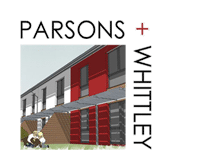The designs at Wimbish were developed as for any other site, following a context study of the site. Fortunately this led us to a rendered finish, which in turn suggested external insulation over thin joint blockwork, a solution we have been using for Code 4 houses for some time so no new skills were required.
It was soon apparent that the floor areas required for social housing in the UK affected the design by virtue of the passivhaus standard being developed for European norms, where floor areas are much larger. Elemental values required walls at 0.88 w/m2/k, and the performance requirements of all the other elements was similarly raised.
An RC raft on 400mm of Dow Floormate carries walls of 190mm Aircrete Blocks with 285mm of Neopor rendered insulation which in turn carry standard trussed rafter roofs supporting 500mm Crown Loft Roll. This construction also assisted the incredibly low air tightness requirement of 0.6 air changes per hour as internal wet plaster provides the majority of the barrier, with all of the joins receiving specialist membranes or tapes. Everything was detailed at 1:2 in order to convey the importance of air tightness and to assist the accuracy of the PHPP modelling.
The dwelling forms have been kept deliberately simple to avoid thermal bridging risks, and porches, meter boxes and brise soleil are all independently supported to avoid penetrating the insulation overcoat. East west orientation of the blocks facilitates passive solar gains, with careful attention to shading to avoid summer overheating.




